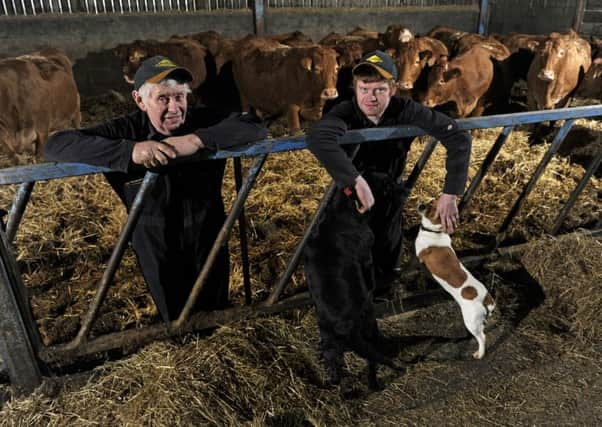Yorkshireman’s thrift that created a farm dynasty


“We had the champion bull last year too but didn’t expect anything this time. When we were looking at what we had ready there were just two in a pen that wanted emptying, and although he didn’t look particularly brilliant at home he looked well at market.
“He was also a bit bigger than we normally send, weighing 610 kilos, as we’re usually around the 550-600 kilo mark for bulls and 450-500 kilos for heifers, so that was another surprise. It’s the third time we’ve won with a bull as we had the champion in 1999 too. We never seem to have a heifer ready, but if we did she’d have to be top drawer as that class can be a different league to the bulls.”
Advertisement
Hide AdAdvertisement
Hide AdIt’s a silver lining for what has been a dark cloud that lingers over the farm as James’ father and respected stockman John was diagnosed with cancer in summer and is not well, but retains his smile and tells of why his father swapped life in Cumbria for Yorkshire back in 1960 and how the farm developed into being largely a cattle concern.
“We came across from Grange over Sands. I was 13 and my dad, James, saw this farm as a golden opportunity to make something better for his two sons - me and my brother Robert. He’d had a rented farm of around 110 acres and had kept sheep and 40 dairy cows.
“In Yorkshireman’s terms I think he came here because it was cheap. He bought the 240 acres of High Bohemia Farm for £10,000. I met my wife-to-be Margaret at a village dance when she couldn’t find her car and I’ve never left here apart from our honeymoon in Edinburgh.”
Cows, whether dairy or sucklers, have been John’s whole life. He gave up the dairy herd many years ago.
Advertisement
Hide AdAdvertisement
Hide Ad“My main reason was that we’d had a good man who left us after having been here 10 years and I looked at our options. We had to either find someone else just as good or sell the cows. To get someone to come here we would have had to go headhunting, so we sold the 70 dairy cows we had and went into beef cattle and they have always been kind to me. Limousins are always saleable and if you treat them right then they will treat you right too.”
James has the same warmth and smile as his father as he tells of today’s farming operation across the family acreage of 330 acres that includes the 90 acres of Greenthwaite Grange, Sutton-on-the-Forest where his uncle Robert lives.
“It’s run as one holding and the farm is beef as the main enterprise and arable. We have a Limousin herd of 90 sucklers producing all of our own replacements and we don’t buy in anything as stores, so we’re pretty much a closed herd apart from when we buy a stock bull.
“After dad finished with the dairy herd and started with sucklers we had everything from Angus X to Hereford X. Since then he has kept buying Limousin bulls and the herd has become purer and purer.
Advertisement
Hide AdAdvertisement
Hide Ad“We have two stock bulls and when we need a new one we usually buy from Millington Grange. Dad has always said we should have two types of bull, one for our breeders with a big frame which will hopefully then make big cows, and a real shapely bull to put on to the heifers off the cows to get more shape and sell well at market.
“Turnout of the herd is late April or the beginning of May and they come back in during late October or early November.
“We’re on heavy land and try to make sure it doesn’t get chewed to bits. This year we brought them in on Bonfire Night. They’ve all been born here so they know their way around but I was still amazed how quickly they came in this year. We’d just finished opening all the gates and the fold door and they were in. They ran all the way back before I could get there.”
James sells at York Auction Centre most weeks of the year. As the herd calves year round there’s always something there or thereabouts ready to go.
Advertisement
Hide AdAdvertisement
Hide Ad“Our bulls are usually ready at between 12-15 months and our heifers a little later at 16-18 months. We achieved £2.35 per kilo for our champion this year and our top price has been £2.75/kilo for a heifer. We feed them twice a day at 6.30am and 4pm. We’re more or less self sufficient with the only feed we buy in being soya protein.”
Cropping is across 130 acres and includes wheat and barley. 50 acres of new grass seed is put down each year.
“The new grass works well with our rotation. Fields are put into one or two year leys. We get three cuts off a one-year ley and that gets our silage yield going. The two-year leys we might cut and then graze them. After two years we then plough them up and we get a really good crop of wheat.”
The Edgars also have Texel sheep farmer Mark Keighley’s sheep on their land as winter grazers. It’s a system that James feels works well as they come on for the winter months and nibble off, levelling the grass.
Advertisement
Hide AdAdvertisement
Hide AdWhile their recent win at York was their third with a bull James also tells of a much earlier champion.
“We had the trophy for best prime lambs in 1989 for a pen of Texel X lambs but we stopped with sheep just before the foot and mouth disease year in 2001.”